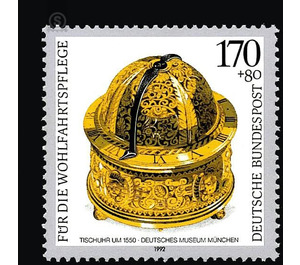welfare: precious old watches from german collections - Germany / Federal Republic of Germany 1992 - 170 Pfennig
Theme: Devices, Items & Instruments
| Country | Germany / Federal Republic of Germany |
| Issue Date | 1992 |
| Face Value | 170.00 |
| Color | multi-colored grey white |
| Perforation | K 13 3/4 |
| Printing Type | Multicolor offset printing |
| Stamp Type | Postage stamp |
| Item Type | Stamp |
| Chronological Issue Number | 1508 |
| Chronological Chapter | GER-BRD |
| SID | 36719 |
| In 35 Wishlists | |
The brilliance and significance of the South German instrument makers are determined by the political conditions. For the Germans, as the Italian political theorist Traiano Boccalini (1556-1613) wrote, had the capacity to build republics and build instruments. It is not land ownership and agrarian economy, as in the case of principalities, but trade and processing that determine the prosperity of politically autonomous urban self-government. In urban republics, this increase in value was determined by the craftsmanship - today we would use the term industrial production - and it was the result of a city culture with a strictly regulated and supervised labor-based guild economy, which ensured continuity and tradition in the watchmaker's craft. Innovations in watchmaking, better in precision mechanics, on the other hand promoted two residences: the royal court in Kassel and the imperial court in Prague. The Landgrave Wilhelm IV of Hesse and Emperor Rudolf II in Prague had themselves operated astronomy and appointed scholars to their farms for the new (natural) sciences. Between 1550 and 1650 complex and complex clocks and vending machines were created in the Free Imperial Cities and the two princely courts, which in Europe encompassed the sum of the technology of this epoch. In the sixteenth and seventeenth centuries, German clocks and automatons were among the most sought-after princely gifts that the German imperial court sent to the High Porte in Constantinople ("Turk worship") and were valuable gifts of the Jesuits to the Chinese court ("propagatio fidei by scientias «); both times the singular and unknown technology of the empire or the occident should impress foreign cultures. The Dutch scientist Christian Huygens was the first to use the pendulum as a regulator of watches, his book Horologium was published in 1658, and the second, extended edition appeared in Paris in 1673. His invention spread quickly and displaced the old Foliot-Waag escapement, as shown by the clock in Nuremberg (60 + 30 Pf), or the variant Foliot-Unruhe, the table clock (170 + 80 Pf) and the figure clock (100 + 50 Pf). The free-swinging pendulum then transformed the minute imprecisely pointing wheel clock into a timepiece that accurately measures the seconds and perfected the mechanical development of the 13th century. The museums of Kassel and Dresden have unique collections of clocks in Germany, which were already built by the ruling princes in the 16th century as physical cabinets. Other museums owe their watch collections to the generosity of passionate collectors who made their life's work available to the public. Furtwangen is the center of the Black Forest watchmaking and shows the third component of the timepiece manufacture: in addition to the Free Imperial Cities and their craft, in addition to the princely residences and the court engineer clocks and musical works (80 + 40 Pf) were produced at home. At the end of the 19th century, with the introduction of American production techniques, the German watch industry developed in the Black Forest. "The clock measures time, but it does not make it," wrote philosopher Arthur Schopenhauer. As a mechanic, however, the clock has remained the only complex machinery that continues to function today over all centuries and today defines our image of past information technology. (Text: Dr. Klaus Maurice, Berlin)


